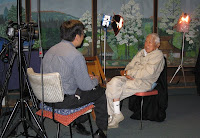July 31, 2008
Jiro Sugidono (84) told how Main Street in Watsonville was a boundary line for the issei. The issei were restricted from the west side (ocean side) of the street. Jiro’s mother had to sit in a car on the east side of Main Street and watch as her five children came out on the sidewalk with possible clothes and suitcases to buy before being removed from Watsonville. If Jiro’s mother approved, the kids would go back and buy their items.
 Tom Mine’s (90) focus was on prewar baseball and farming. Tom talked about the long car trips nisei ballplayers made to play against teams in Florin, Sacramento and San Jose. He also shared how he became successful in the difficult business of farming by gradually adding more and more land.
Tom Mine’s (90) focus was on prewar baseball and farming. Tom talked about the long car trips nisei ballplayers made to play against teams in Florin, Sacramento and San Jose. He also shared how he became successful in the difficult business of farming by gradually adding more and more land.
Mas Hashimoto (73) is a retired high school Social Studies teacher who grew up and taught in Watsonville. He told a touching story of having his pet dog “Sunny” while incarcerated at Poston. Mas has a wealth of knowledge about Japanese American history in Watsonville and shares this information with volunteer school visits to thousands of students each year.

